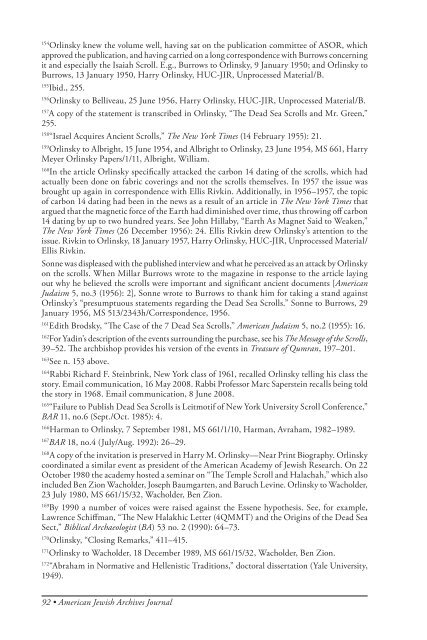The American Jewish Archives Journal, Volume LXI 2009, Number 1
The American Jewish Archives Journal, Volume LXI 2009, Number 1
The American Jewish Archives Journal, Volume LXI 2009, Number 1
You also want an ePaper? Increase the reach of your titles
YUMPU automatically turns print PDFs into web optimized ePapers that Google loves.
154Orlinsky knew the volume well, having sat on the publication committee of ASOR, which<br />
approved the publication, and having carried on a long correspondence with Burrows concerning<br />
it and especially the Isaiah Scroll. E.g., Burrows to Orlinsky, 9 January 1950; and Orlinsky to<br />
Burrows, 13 January 1950, Harry Orlinsky, HUC-JIR, Unprocessed Material/B.<br />
155Ibid., 255.<br />
156Orlinsky to Belliveau, 25 June 1956, Harry Orlinsky, HUC-JIR, Unprocessed Material/B.<br />
157A copy of the statement is transcribed in Orlinsky, “<strong>The</strong> Dead Sea Scrolls and Mr. Green,”<br />
255.<br />
158 “Israel Acquires Ancient Scrolls,” <strong>The</strong> New York Times (14 February 1955): 21.<br />
159Orlinsky to Albright, 15 June 1954, and Albright to Orlinsky, 23 June 1954, MS 661, Harry<br />
Meyer Orlinsky Papers/1/11, Albright, William.<br />
160In the article Orlinsky specifically attacked the carbon 14 dating of the scrolls, which had<br />
actually been done on fabric coverings and not the scrolls themselves. In 1957 the issue was<br />
brought up again in correspondence with Ellis Rivkin. Additionally, in 1956–1957, the topic<br />
of carbon 14 dating had been in the news as a result of an article in <strong>The</strong> New York Times that<br />
argued that the magnetic force of the Earth had diminished over time, thus throwing off carbon<br />
14 dating by up to two hundred years. See John Hillaby, “Earth As Magnet Said to Weaken,”<br />
<strong>The</strong> New York Times (26 December 1956): 24. Ellis Rivkin drew Orlinsky’s attention to the<br />
issue. Rivkin to Orlinsky, 18 January 1957, Harry Orlinsky, HUC-JIR, Unprocessed Material/<br />
Ellis Rivkin.<br />
Sonne was displeased with the published interview and what he perceived as an attack by Orlinsky<br />
on the scrolls. When Millar Burrows wrote to the magazine in response to the article laying<br />
out why he believed the scrolls were important and significant ancient documents [<strong>American</strong><br />
Judaism 5, no.3 (1956): 2], Sonne wrote to Burrows to thank him for taking a stand against<br />
Orlinsky’s “presumptuous statements regarding the Dead Sea Scrolls.” Sonne to Burrows, 29<br />
January 1956, MS 513/2343h/Correspondence, 1956.<br />
161Edith Brodsky, “<strong>The</strong> Case of the 7 Dead Sea Scrolls,” <strong>American</strong> Judaism 5, no.2 (1955): 16.<br />
162For Yadin’s description of the events surrounding the purchase, see his <strong>The</strong> Message of the Scrolls,<br />
39–52. <strong>The</strong> archbishop provides his version of the events in Treasure of Qumran, 197–201.<br />
163See n. 153 above.<br />
164Rabbi Richard F. Steinbrink, New York class of 1961, recalled Orlinsky telling his class the<br />
story. Email communication, 16 May 2008. Rabbi Professor Marc Saperstein recalls being told<br />
the story in 1968. Email communication, 8 June 2008.<br />
165 “Failure to Publish Dead Sea Scrolls is Leitmotif of New York University Scroll Conference,”<br />
BAR 11, no.6 (Sept./Oct. 1985): 4.<br />
166Harman to Orlinsky, 7 September 1981, MS 661/1/10, Harman, Avraham, 1982–1989.<br />
167BAR 18, no.4 (July/Aug. 1992): 26–29.<br />
168A copy of the invitation is preserved in Harry M. Orlinsky—Near Print Biography. Orlinsky<br />
coordinated a similar event as president of the <strong>American</strong> Academy of <strong>Jewish</strong> Research. On 22<br />
October 1980 the academy hosted a seminar on “<strong>The</strong> Temple Scroll and Halachah,” which also<br />
included Ben Zion Wacholder, Joseph Baumgarten, and Baruch Levine. Orlinsky to Wacholder,<br />
23 July 1980, MS 661/15/32, Wacholder, Ben Zion.<br />
169By 1990 a number of voices were raised against the Essene hypothesis. See, for example,<br />
Lawrence Schiffman, “<strong>The</strong> New Halakhic Letter (4QMMT) and the Origins of the Dead Sea<br />
Sect,” Biblical Archaeologist (BA) 53 no. 2 (1990): 64–73.<br />
170Orlinsky, “Closing Remarks,” 411–415.<br />
171Orlinsky to Wacholder, 18 December 1989, MS 661/15/32, Wacholder, Ben Zion.<br />
172 “Abraham in Normative and Hellenistic Traditions,” doctoral dissertation (Yale University,<br />
1949).<br />
92 • <strong>American</strong> <strong>Jewish</strong> <strong>Archives</strong> <strong>Journal</strong>

















